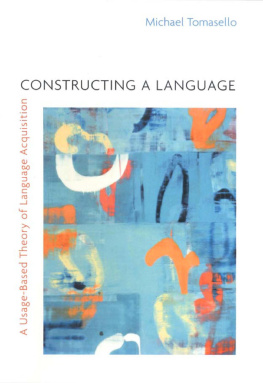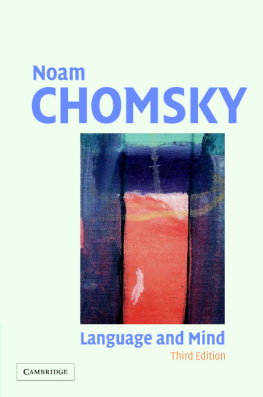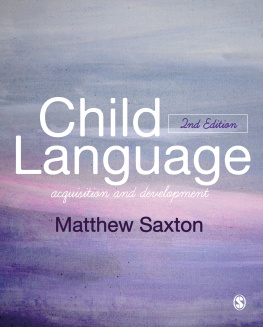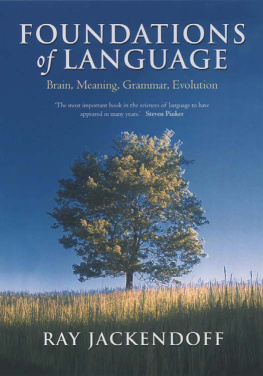Language Acquisition
The Growth of Grammar
Maria Teresa Guasti
The MIT Press
Cambridge, Massachusetts
London, England
2016 Massachusetts Institute of Technology
All rights reserved. No part of this book may be reproduced in any form by any electronic or mechanical means (including photocopying, recording, or information storage and retrieval) without permission in writing from the publisher.
This book was set in Times LT Std by Toppan Best-set Premedia Limited. Printed and bound in the United States of America.
Library of Congress Cataloging-in-Publication Data
Names: Guasti, Maria Teresa, author.
Title: Language acquisition : the growth of grammar / Maria Teresa Guasti.
Description: Second edition. | Cambridge, MA : The MIT Press, [2016] | Includes bibliographical references and index.
Identifiers: LCCN 2016020050 | ISBN 9780262529389 (pbk. : alk. paper)
eISBN 9780262342261
Subjects: LCSH: Language acquisition.
Classification: LCC P118 .G83 2016 | DDC 401/.93--dc23 LC record available at https://lccn.loc.gov/2016020050
ePub Version 1.0
d_r0
To Aditi, Alessandro, and Natale
To the memory of Wilma Preti who made me love scientific discovery
Speaking is improvisation (and signing as well)
Preface
My goal in writing this introduction to language acquisition has been to present a wide range of evidence and theoretical advances to upper undergraduate and graduate students as well as to researchers interested in new developments in language acquisition.
In presenting acquisition data and theories, I have adopted concepts developed in linguistic research, thereby assuming that the reader is somewhat familiar with themsay, from having taken an introductory linguistics course or having read an introductory textbook.
, these chapters present some issues that also pertain to the computational system. While I adopt Hauser, Chomsky, and Fitch's (2002) organization of the language faculty, I do not adopt the claims underlying it (see the cited article for discussion).
, on pathological conditions of language acquisition, has been expanded to include not only specific language impairment, but also conditions of mental retardation (Williams and Down syndrome) and a discussion of language problems in children with dyslexia. Central to this chapter is the notion of linguistic profiles. One goal is to show that a linguistic analysis may provide new insights into the nature of the disorders and, in general, into the nature of language.
on language disorders consider aspects of literacy, as it relates to language. Although the book is about language acquisition in natural settings, we should bear in mind that from the time children enter formal education, something happens to the language acquisition process that may influence their learning potential.
Since the first edition of this book, the field has grown exponentially not only in terms of research coverage, but also in crosslinguistic terms. This expansion is reflected here. Beyond studies on the acquisition of many languages spoken in Europe or in the United States, studies on the acquisition of languages spoken in Asia and Africa have challenged extant theories, supported old claims on the structure of language, and brought fresh air into the field. Therefore, this edition is less Anglocentric than the first.
Various innovations in the field are highlighted in this edition. One is the study of the infant brain while it processes language. In this area, interesting new evidence shows some specialization for speech already at birth, a finding compatible with the nativist approach endorsed in this book. From this, we should not rush to the conclusion that speech is special. It may be, but there is more than that. Shortly after birth, infants are also sensitive to linguistic signs, although this sensitivity fades away if not supported by the environment. These facts suggest that the human capacity for language is amodal. Another innovation is the study of children's understanding of sentences using online methods, such as the visual world paradigm or event-related potentials. This line of research reveals a precocious knowledge of linguistic properties. Other studies based on more traditional methods, such as picture-to-sentence matching, report prima facie contrasting results. I think there is no opposition here. These two approaches inform us of different aspects of language acquisition. With online methods, we can gather information about when children display some linguistic knowledge; with offline methods, more influenced by cognitive demands, we collect information about the complexity of a given structure. Methodology matters, as Crain and Thornton (1998) make clear.
) study questions and exercises (to help the reader grasp the major concepts by trying to design experiments or explain certain facts). A glossary of terms appears at the end of the book.
. When necessary, I use vP and VP; otherwise, I use VP to refer to the verbal domain. The terms function word and functional morpheme refer to closed-class items in a language (e.g., determiners, auxiliaries, inflections). Traces of movement or the position in which some displaced item must be interpreted are indicated with t or by enclosing the displaced material in angle brackets (e.g., ). The terms trace, copy, and gap are used interchangeably to refer to this information.
Throughout the text, I give examples of children's utterances. To avoid repetition, I acknowledge all the sources of the data here rather than in the text. Data from the two French children Daniel and Nathalie are from Lightbown 1977; data from the German child Simone are from Miller 1976; data from the Danish children Jens and Anne are from Hamann and Plunkett 1998; and data from the Italian child Arianna are my own. Unless otherwise acknowledged in the text, the other data come from the CHILDES database (MacWhinney and Snow 1985). Sources include Miquel Serra and Rosa Sole (for Guillem); Wijnen 1992 (for Hein, Thomas); Bol 1996 (for Peter); Brown 1973 (for Adam, Eve, Sarah); Suppes 1974 (for Nina); Schaerlaekens and Gillis 1987 (for Maarten); Suppes, Smith, and Leveill 1973 (for Philippe); Christian Champaud (for Grgoire); Wagner 1985 (for Andreas); and Cipriani et al. 1989 (for Diana, Guglielmo, Martina, Rosa). When utterances from particular children are reported, the exact age is indicated. When group studies are discussed, the age reported refers to the mean age of the group, even if the term mean age is not explicitly mentioned.
In this edition, as in the previous one, language acquisition is seen as the result of an inborn structured endowment coupled with a number of mechanisms, language-specific or not, that interact with the specific language spoken in the child's environment. The claim of language specificity has been and is the source of hot debate. Starting with Saffran et al. (1999), some authors have drawn attention to statistical learning and general-purpose mechanisms as powerful devices for language acquisition. Although it is recognized that these mechanisms are not sufficient to explain the whole process (Aslin and Newport 2014), ideological commitment still prevents some in the field from seeing the importance of language specificity. Bonatti et al. (2005) and Hochmann et al. (2011) have demonstrated that statistical learning is not blind to linguistic structure in the form of consonants and vowels. Similarly, Peretz et al. (2012) have demonstrated that individuals affected by congenital amusia could use a statistical learning mechanism to learn novel words, but not to learn a novel sequence of tones. Control individuals could learn both. The dissociation found in individuals with congenital amusia shows that statistical learning does not ignore the material to which it applies. If it is a blind general-purpose mechanism, why should this be so?


![Andrew Radford - Linguistics An Introduction [Second Edition]](/uploads/posts/book/882994/thumbs/andrew-radford-linguistics-an-introduction.jpg)






